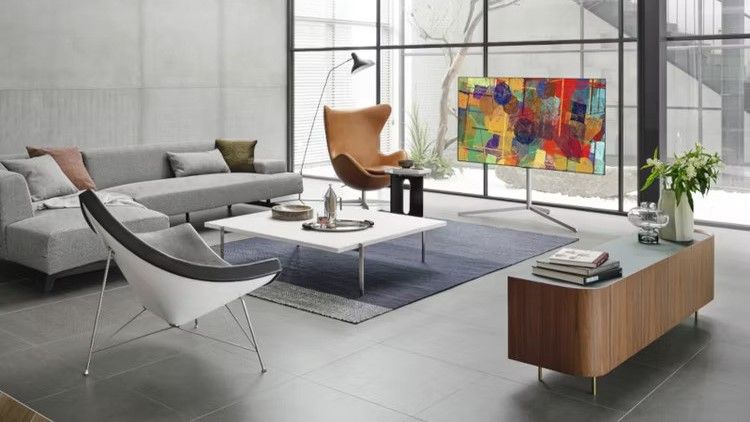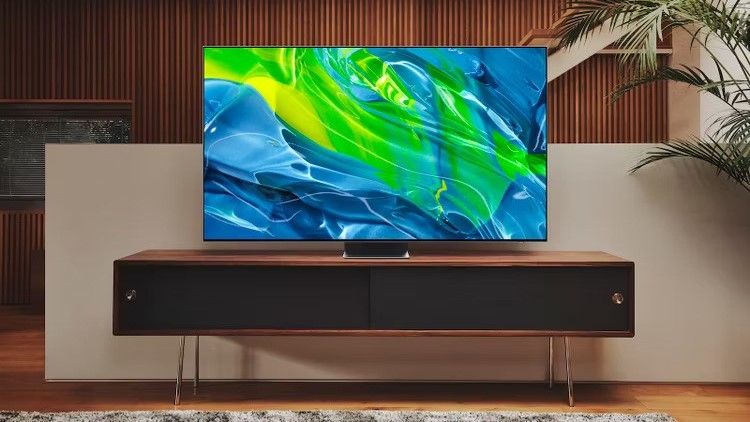Main points
- OLED TV: Self-illuminating pixels for absolute black levels and contrast. Great colors and slim design.
- QD-OLED TVs: Brighter and more colorful than OLED, but more expensive and use blue light and quantum dots.
- Mini LED TV: Affordable, with precise backlighting and better black levels. Not as advanced as OLED/MicroLED.
If you’re shopping for a new TV in 2024, you’ll likely see buzzwords like OLED TV, QD-OLED TV, Mini LED TV, and even MicroLED TV.
If you’re wondering what the differences are between these technologies, read on as we’ll detail the basics, benefits, and unique features of each to help you make sense of it all.

QLED vs. OLED TVs: What’s the real difference? What does it mean?
Infomercials are fun but have too much jargon. We break down the differences between QLED and OLED technologies, how they work and which type is better for you.
 OLED TVs: What to know
OLED TVs: What to know
Excellent color saturation and slim design
Organic light-emitting diode technology, better known as OLED, has been around for nearly a decade and is used in televisions, cell phones and other small-screen portable devices.
OLEDs are much simpler to set up than traditional LCDs, thanks to carbon-based organic compounds that emit light when electric current passes through them.
OLEDs are much simpler to set up than traditional LCDs, thanks to carbon-based organic compounds that produce light when electricity is passed through them. This means that each of the millions of pixels in an OLED is self-illuminating and can be turned on or off individually, ensuring zero light leakage from adjacent pixels. In fact, since they can be turned off completely, black levels are absolute and contrast is excellent.
phillips
OLED TV advantages
getting brighter day by day
OLED TVs are also known for their excellent color saturation and accuracy, although they tend not to be as bright as high-end LED TVs. That’s because the harder you try to make your TV brighter, the shorter the lifespan of the organic compounds is and the risk of so-called “screen burn” increases. However, recent OLED TVs are finding ways to solve this problem, such as incorporating heat sinks into the panels to increase driving power while keeping them cool, and introducing new technologies to help them – such as microlens arrays.
This involves a layer of tiny lenses on top of the OLED pixels that better focus the emitted light onto the viewer. As a result, the TV doesn’t have to work any harder to reach a peak brightness of 2,000 nits.

3 reasons to buy a Sony TV instead of a Samsung TV
I’m a loyal Samsung user, but Sony’s latest innovation has me skeptical.
Power consumption also benefits from the lack of a backlight, as does the depth of OLED TVs, as simpler internals allow panels to be only a few millimeters thick. You do need some space for connections and speakers, though, so they’re rarely this slim all the way around.
Some OLED TVs have a separate media connection box to solve this problem, which allows the panel to sit flush with the wall.
One thing to note with OLED display technology is that because it’s organic, it has a shorter lifespan than its competitors. Over time, the pixelation effect may fade and the image may appear less bright or vibrant. However, this takes many years.
Perhaps more important to note is that OLED is similar to older plasma TV technology in terms of screen retention. In the worst-case scenario, you might even experience permanent screen burn, although TV manufacturers have taken several steps to help prevent this from happening in newer models.
Samsung
QD-OLED TVs: What you need to know
Brighter and better color quality than traditional OLED
QD-OLED is a new version of OLED developed by Samsung and used in its OLED range as well as Sony’s new flagship products. The name comes from the quantum dot technology Samsung uses in its QLED range, taking an OLED approach. This idea? It combines the best of both worlds into one screen.

I watched Taylor Swift’s Eras tour on Disney+ using Apple Vision Pro.The thing is like this
Taylor Swift’s The Eras Tour (Taylor’s Version) is now available on Disney+, and watching it with Apple Vision Pro is eye-opening in many ways.
 QD-OLED TV advantages
QD-OLED TV advantages
Highest quality, highest price
In a traditional OLED TV, a filter is used to convert the white light emitted by each pixel into red, green and blue sub-pixels. In QD-OLED, the light from the OLED material is blue, and each pixel is divided into three: a blue sub-pixel containing only the original OLED material, then red and green sub-pixels created from red and green quantum dots. pixels. Need white light? Combine these three and you get it.
QD-OLED claims to be brighter than traditional OLED while also offering the best color quantity.
Since no filters are required, QD-OLED claims to be brighter than traditional OLED while also delivering optimal color quantity. The only downside is that it’s more expensive than traditional OLED, and image retention still exists.
Hisense
Mini LED TV: What you need to know
Excellent brightness, better black levels and more affordable price
Mini LED is a fairly new TV technology. This is also the only one here that refers to the backlight rather than the screen technology itself.
Mini LED backlighting is similar to other LED technologies that sit directly behind the LCD substrate, and much like these technologies, it emits light through non-self-illuminating pixels to display images on the screen. However, unlike other LED backlights (even local dimming backlights), it’s made up of thousands of tiny LEDs that can be turned on or off in multiple smaller areas.
For example, LG’s current range of Mini LED TVs use 30,000 LEDs in the backlight, directly behind the LCD panel. These are divided into approximately 2,500 zones and can be turned on/off, dimmed or brightened exactly as required.
Samsung
Mini LED TV Advantages
Best for your budget
One of the biggest advantages of Mini LED technology is its precision, which delivers better black levels and greater color saturation and accuracy. Additionally, Mini LED reduces light leakage because the LED area is much smaller than usual.
There’s no direct comparison to OLED or MicroLED technology, where each pixel is self-illuminating and therefore more precise, but you can get better images than you’d typically see from traditional LEDs.
The end result isn’t directly comparable to OLED or MicroLED technology, where each pixel is self-illuminating and therefore more precise, but you can get a better image than you’d typically see from traditional LEDs.
Another benefit of Mini LED TVs is that they are the cheapest to make, and their retail prices often reflect this.
Samsung
MicroLED TVs: What to know
Excellent brightness, excellent black levels and modular design
Like OLED, MicroLED technology uses self-illuminating pixels combined with multi-color micro-LEDs to deliver very accurate images without the need for a backlight.
This offers similar performance to OLED, especially in terms of black levels, as each pixel can be turned on or off at will. However, since the pixels are made from inorganic materials, they can technically also be brighter without worrying about longevity, so it’s possible to provide MicroLED TVs with higher contrast and brightness.
This means HDR control is more pronounced on MicroLED panels, with more extreme black levels and brightness compared to other technologies.
Samsung
MicroLED TV Advantages
TV technology of the future
MicroLED technology is more flexible, as evidenced by Samsung’s The Wall, which is modular and uses different screen tiles to be pieced together to form a larger display.
The smallest MicroLED TV released to date is 77 inches, while the original Wall TV was 4K and 146 inches.
However, there are some caveats to MicroLEDs. First, since it consists of groups of pixels (one module) measuring one millimeter, it can only be used in larger screen sizes, otherwise you lose resolution. The smallest MicroLED TV released to date is 77 inches, while the original Wall TV was 4K and 146 inches.
However, other manufacturers are developing micron modules, so this issue may be resolved at some point in the future.
Another disadvantage of MicroLED is that it is currently extremely expensive. For example, Samsung’s cheapest MicroLED TV costs $80,000. That means it’s really not a consumer option now, but one day…

Samsung launches transparent MicroLED screen at CES that looks like glass
Samsung made a splash at CES 2024 with a stunning transparent display that was the result of six years of research and development.





